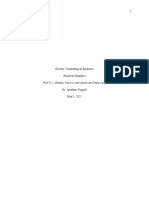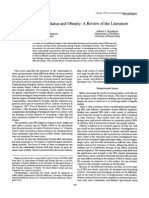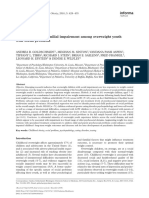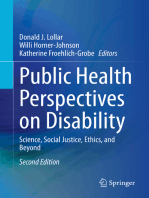Is Obesity in Australia A Trouble or An Issue?
Is Obesity in Australia A Trouble or An Issue?
Uploaded by
gabCopyright:
Available Formats
Is Obesity in Australia A Trouble or An Issue?
Is Obesity in Australia A Trouble or An Issue?
Uploaded by
gabOriginal Description:
Original Title
Copyright
Available Formats
Share this document
Did you find this document useful?
Is this content inappropriate?
Copyright:
Available Formats
Is Obesity in Australia A Trouble or An Issue?
Is Obesity in Australia A Trouble or An Issue?
Uploaded by
gabCopyright:
Available Formats
Is obesity in Australia a trouble or an issue?
Obesity is widely considered a major concern in Australia and many parts of the
developed world. It has been estimated that 63.4% of Australian adults are
overweight or obese (Australian Bureau of Statistics 2013), with a number of
serious health concerns, including cardiovascular disease, high blood pressure and
type 2 diabetes (Australian Bureau of Statistics 2013), arising from obesity. Media
coverage of obesity has traditionally portrayed it as a disease or epidemic,
simultaneously the result of factors out of a persons control and a problem of an
individuals self control and willpower (Boero 2013). Using C. Wright Mills
concept of the sociological imagination, this essay will argue that obesity in
Australia falls under Mills category of issues rather than troubles, in that the
personal troubles associated with obesity are exacerbated, amplified and potentially
caused by, societal structures occurring on a larger scale. As it has been found that
there is a strong link between obesity and overweight in childhood and related
health complications in later life, this essay will focus on the societal structures that
contribute to childhood obesity, and by extension, obesity in adulthood. Following
an overview of Mills definition of the sociological imagination will be presented,
this essays discussion will focus on the ways in which a culture of passive,
sedentary entertainment consumption, food producers and marketers targeting of
children and the link between socioeconomic disadvantage and poor health
guidance in childhood are all structures found within modern Australian society
that contribute to obesity and fit within Mills categorization of issues.
According to C. Wright Mills (2010) the sociological imagination enables
sociologists to understand the larger societal structures at work in terms of their
meaning for the personal lives of individualsin the words of Giddens and Sutton,
to think ourselves away from the familiar routines of our daily lives in order to
look at them from a new point of view (2013, p5). Fundamental to this theory is
the idea of troubles versus issues. Troubles are a private matter; they occur on a
personal level, within the limited areas of an individuals life over which they have
direct control and awareness. Issues exist on a macro scale, expressing larger
trends; they transcend local environments and reflect the larger historical and
societal structures present in society (Mills 2010).
1
These structures are the result of the patterns of relationships between people,
groups and institutions (Giddens & Sutton 2013). It would not be untrue to say that
a person who is obese for psychological, medical or any other reasons is
experiencing a personal trouble; however, the prevalence of obesity in Australia is
a sociological issue which is determined by the impact of societal structures upon
the lives of individuals, three instances of which are discussed below.
One example of a societal structure contributing to childhood obesity in Australia is
a lifestyle of passive entertainment consumption. According to Brown, Nicholson,
Broom and Bittman (2010), children in contemporary society spend more of their
leisure time engaged in passive entertainment rather than physical pursuits when
compared with previous generations. As well as being a sedentary activity,
television and other passive entertainment has been found to be associated with an
increased consumption of energy dense snack foods (Brown et al. 2010). As body
weight is the result of the balance between energy consumption and energy
expenditure, this combination can increase a childs risk of developing unhealthy
lifestyle behaviours leading to obesity in later life (Brown et al. 2010). The role that
television viewing plays in childhood obesity is a societal structure in that it
involves a relationship between individuals and the social institution of the
entertainment industry, on a large scale throughout Australian society.
Entertainment consumption habits are not the only example of such a structure. The
content of the entertainment also matters and the next section will examine the
relationship between food advertising and obesity.
Another sociological factor implicated in the rising rates of childhood obesity is
food manufacturers whose marketing targets children. Companies working with
huge budgets and aided by sophisticated new technologies are able to circumvent
parental supervision and find direct pathways to reach young audiences (Linn &
Novosat 2008). Advertising plays an important role in influencing childrens brand
preferences and habits, and a significant portion of this marketing is for food of
questionable nutritional value (Linn & Novosat 2008). In addition to traditional
television and digital advertising, marketers employ innovative manipulation
techniques, such as enlisting the aid of child psychologists to help exploit childrens
developmental vulnerabilities (Linn & Novosat 2008).
2
As a result of the increasing ingenuity of this advertising, parents can have
difficulty keeping pace with food manufacturers in influencing their childrens
dietary preferences (Linn & Novosat 2008). In this case, the relationship is between
the social institution of food advertising and the social groups of families as well as
individuals. This relationship reduces parents ability to guide their childrens
eating choices in a healthy direction, in addition to exploiting the navet of child
consumers. The harmful effects of this societal relationship, as well as that between
children and the entertainment industry mentioned above, could both be
exacerbated by another social issue, namely socioeconomic disadvantage.
A study by Lee, Harris & Gordon-Larsen (2008) confirmed a link between obesity
rates in children and socioeconomic disadvantage. Although much of their research
was conducted in America, as Australia is a similarly industrialised Western
society, many of their points can be applied generally to the issue of obesity in
Australia. When children live at home, their parents establish and monitor their
lifestyles, including diet, physical activity, entertainment consumption and the
regularity of meals (Lee et al. 2008). As a result of constraints on their time due to
work (for example if both parents work full time, or single parents who also work),
parents in financial hardship are often less able to monitor their children so as to
ensure compliance with healthy routines and habits (Lee et al. 2008). This may
increase the risk of children developing unhealthy habits through unsupervised
meals, increased exposure to television and decreased physical activity (Lee et al.
2008).
When considered on an individual level, obesity can certainly be understood as a
personal trouble; however, the profound influence of societal structures upon the
ways in which individuals make their decisions and interact with their environment
means that the widespread incidence of obesity in Australia must be appreciated as
a sociological issue. The three relationships between individuals, groups and
institutions mentioned above are all examples of how societal structures can place
individuals in situations where their personal troubles are vulnerable to
amplification or exacerbation. In order to meaningfully engage with the topic of
obesity in Australia, these structures must be acknowledged and examined in order
to appreciate the role they play in this widespread sociological issue.
3
List of Works Cited
Australian Bureau of Statistics, 2013, Australian Health Survey: First Results,
2011-12, viewed 17 March 2014,
<http://www.abs.gov.au/ausstats/abs@.nsf/Lookup/4364.0.55.001Chapter
4122011-12>.
Boero, N 2013, Obesity in the Media: social science weighs in, Critical Public
Health, vol. 23, issue 3, pp. 371-380.
Brown, JE, Nicholson, JN, Broom, D & Bittman, M 2010, Television Viewing by
School Age Children: Associations with Physical Activity, Snack Food
Consumption and Unhealthy Weight, Social Indicators Research, vol.
101, issue 2 pp. 221-225.
Giddens, A & Philip, WS 2013, Sociology, 7th edn, Polity Press, Cambridge.
Lee, H, Harris, KM & Gordon-Larsen, P 2008 Life Course Perspectives on the
Links Between Poverty and Obesity During the Transition to Young
Adulthood, Population Research and Policy Review, vol. 28, issue 4,
pp. 505-532.
Linn, S & Novosat CL 2008 Calories For Sale: Food Marketing to Children in the
Twenty- First Century, The Annals of the American Academy of Political
and Social Science, vol. 615, pp. 133-155.
Mills, CW 2010, Private Troubles, Public Issues in Giddens, A & Phillip WS (ed)
Sociology: Introductory Readings, Polity Press, Cambridge, pp. 5-8.
You might also like
- High Rise Mixed-Use Space ProgrammingDocument4 pagesHigh Rise Mixed-Use Space ProgrammingNino Ylagan100% (1)
- API Recommended Practice 10B Recommended Practice For Testing Well CementsDocument33 pagesAPI Recommended Practice 10B Recommended Practice For Testing Well CementsGio Llanos100% (2)
- 04/16/21 - Gideon's Army Weekly Conference Call Saturday 9 Am CST For American Political PrisonersDocument26 pages04/16/21 - Gideon's Army Weekly Conference Call Saturday 9 Am CST For American Political PrisonersLoneStar1776No ratings yet
- Sbi3u Unit Plan Wolinski: Download NowDocument5 pagesSbi3u Unit Plan Wolinski: Download NowAbhishek SainiNo ratings yet
- HSH207 ThiThuyTrangLY AT1Document9 pagesHSH207 ThiThuyTrangLY AT1Huong NguyenNo ratings yet
- Chapter 1Document7 pagesChapter 1Michael Charles James GingcoNo ratings yet
- Research Paper - Childhood ObesityDocument12 pagesResearch Paper - Childhood Obesitykbschulz100% (2)
- BPH UnderstandingTheRelationshipDocument25 pagesBPH UnderstandingTheRelationshipXiiAhnChoiPenjahatKunukNo ratings yet
- Brady SamplepaperDocument9 pagesBrady Samplepaperapi-338403749No ratings yet
- Adolescent Obesity and Social Networks: Volume 6: No. 3 JULY 2009Document8 pagesAdolescent Obesity and Social Networks: Volume 6: No. 3 JULY 2009Martha Patricia López PimentelNo ratings yet
- Reading TranfadirDocument13 pagesReading TranfadirCindy JiaNo ratings yet
- Shankles-Paf 112 Final PaperDocument7 pagesShankles-Paf 112 Final Paperapi-548632096No ratings yet
- Obesity Obesity ResearchDocument27 pagesObesity Obesity ResearchalefgardNo ratings yet
- Advocay ReportDocument14 pagesAdvocay Reportapi-253925721No ratings yet
- Stunting Policy from a Social Aspect Perspective: A Systematic Literature ReviewDocument8 pagesStunting Policy from a Social Aspect Perspective: A Systematic Literature ReviewAJHSSR JournalNo ratings yet
- Completed ProposalDocument12 pagesCompleted Proposalapi-283243397No ratings yet
- Report:: How Do Eating Habits Affect Self-Image Among Students in AUB?Document25 pagesReport:: How Do Eating Habits Affect Self-Image Among Students in AUB?ktraboulsi1No ratings yet
- Rowe Formal1Document6 pagesRowe Formal1api-313913292No ratings yet
- First Name, Middle Initials, Last Name Department, University Name Course Code: Course Name Tutor DateDocument8 pagesFirst Name, Middle Initials, Last Name Department, University Name Course Code: Course Name Tutor DateRosanaNo ratings yet
- Chapter 2Document3 pagesChapter 2Michael Charles James GingcoNo ratings yet
- Paper 1 PDFDocument27 pagesPaper 1 PDFNicolas BaronNo ratings yet
- Health PolicyDocument7 pagesHealth PolicyJoshMatthewsNo ratings yet
- Environmental_Influences_on_Maternal_and_Child_HeaDocument3 pagesEnvironmental_Influences_on_Maternal_and_Child_Heafouziazaman98No ratings yet
- Thesis Statement On Eating Disorders and The MediaDocument7 pagesThesis Statement On Eating Disorders and The MediaWriteMyPaperPleaseNewHaven100% (2)
- Socioeconomic Status and ObesityDocument16 pagesSocioeconomic Status and ObesityElena LilyNo ratings yet
- Sedentary Lifestyle in The UK 1Document11 pagesSedentary Lifestyle in The UK 1Mzito Jnr MzitoNo ratings yet
- Policy Lesson Poverty RerductionDocument11 pagesPolicy Lesson Poverty Rerductionassefata2127No ratings yet
- Assessing Developmental Changes and Trends in Adolescence and Older Age - EditedDocument11 pagesAssessing Developmental Changes and Trends in Adolescence and Older Age - Editedmike writerNo ratings yet
- 2 SBH Final PaperDocument12 pages2 SBH Final Paperapi-240690004No ratings yet
- Mayowa's ProjectDocument39 pagesMayowa's Projectopeyemipeter4realNo ratings yet
- 10b. Obesity Prevention in Children - Media Campaigns, Stigma, and EthicsDocument4 pages10b. Obesity Prevention in Children - Media Campaigns, Stigma, and EthicsShrisai KharatNo ratings yet
- Cause and Effects of Obesity On Teen Population of UsaDocument4 pagesCause and Effects of Obesity On Teen Population of UsaAsif DeeproNo ratings yet
- 301 Campaign Proposal 1 2Document16 pages301 Campaign Proposal 1 2api-723129475No ratings yet
- MR AND MRS PATEL - EditedDocument7 pagesMR AND MRS PATEL - EditedyyNo ratings yet
- London Borroughs ProjectDocument18 pagesLondon Borroughs Projectpandafever0.0No ratings yet
- Health Services Research - 2003 - Finch - Socioeconomic Gradients and Low Birth‐Weight Empirical and Policy ConsiderationsDocument24 pagesHealth Services Research - 2003 - Finch - Socioeconomic Gradients and Low Birth‐Weight Empirical and Policy ConsiderationsAxelNo ratings yet
- Sample Essay 2Document6 pagesSample Essay 2Nan Houm SianNo ratings yet
- Formal 1Document5 pagesFormal 1api-302062745No ratings yet
- Developmental Psych First EssayDocument2 pagesDevelopmental Psych First Essayaspen8155No ratings yet
- Cause of ObesityDocument9 pagesCause of Obesitysidneygreene3026No ratings yet
- Poverty's Influence On The Health of America 1Document15 pagesPoverty's Influence On The Health of America 1api-281018238No ratings yet
- Reversing The Trend of Childhood ObesityDocument6 pagesReversing The Trend of Childhood ObesitySharon V.No ratings yet
- Community Health Final-Nursing Final Turn inDocument8 pagesCommunity Health Final-Nursing Final Turn inapi-719825532No ratings yet
- Facors IsolationDocument15 pagesFacors IsolationMohd SyazaliNo ratings yet
- Ethical Dilemmas of Family Planning and Population Control in Developing CountriesDocument8 pagesEthical Dilemmas of Family Planning and Population Control in Developing Countriesdamilola ajimudaNo ratings yet
- InglesDocument11 pagesInglescoloresNo ratings yet
- Childhood ObesityDocument6 pagesChildhood ObesitybonfaceNo ratings yet
- Obesity Dissertation QuestionsDocument8 pagesObesity Dissertation QuestionsBuyCustomPapersCanada100% (2)
- Compare and Contrast Between US and China EssayDocument4 pagesCompare and Contrast Between US and China Essayrenokakumari12No ratings yet
- Psychosocial and Familial Impairment Among Overweight Youth With Social ProblemsDocument8 pagesPsychosocial and Familial Impairment Among Overweight Youth With Social Problemsmutiara hapkaNo ratings yet
- Childhood Obesity ResearchDocument12 pagesChildhood Obesity ResearchMarkNo ratings yet
- Obesity Research PaperDocument5 pagesObesity Research PaperRyan Washington100% (1)
- Causes of Inequality in HealthDocument20 pagesCauses of Inequality in HealthLisa100% (1)
- Health Education As An Arena For Adult Educators' Engagement in Social JusticeDocument3 pagesHealth Education As An Arena For Adult Educators' Engagement in Social JusticedaharakaNo ratings yet
- Soci 290 Assignment 3Document6 pagesSoci 290 Assignment 3ANA LORRAINE GUMATAYNo ratings yet
- F26 01.edited - EditedDocument6 pagesF26 01.edited - EditedMORRIS ANUNDANo ratings yet
- Children: Understanding School-Aged Childhood Obesity of Body Mass Index: Application of The Social-Ecological FrameworkDocument16 pagesChildren: Understanding School-Aged Childhood Obesity of Body Mass Index: Application of The Social-Ecological FrameworkAnung Irawan PNo ratings yet
- Fpsyg 11 575170Document18 pagesFpsyg 11 575170muanching zouNo ratings yet
- Exploring The Relationship Between Education and ObesityDocument41 pagesExploring The Relationship Between Education and ObesitycwaranedNo ratings yet
- Obesity Related Dissertation TopicsDocument7 pagesObesity Related Dissertation TopicsHelpWritingMyPaperSingapore100% (2)
- DIBC Final PaperDocument25 pagesDIBC Final PaperPaula Daniela Quimbayo AcuñaNo ratings yet
- "More Than A Diet": A Qualitative Investigation of Young Vegan Women's Relationship To FoodDocument34 pages"More Than A Diet": A Qualitative Investigation of Young Vegan Women's Relationship To FoodIHLIHLNo ratings yet
- Social Media and Eating Disorder Psychopathology: A Systematic ReviewDocument21 pagesSocial Media and Eating Disorder Psychopathology: A Systematic ReviewJosé Luis PsicoterapeutaNo ratings yet
- Public Health Perspectives on Disability: Science, Social Justice, Ethics, and BeyondFrom EverandPublic Health Perspectives on Disability: Science, Social Justice, Ethics, and BeyondNo ratings yet
- End-Stage Renal Disease Description of DiseaseDocument5 pagesEnd-Stage Renal Disease Description of DiseaseZhailyn Joy DumlaoNo ratings yet
- Assessment Of, For, As LearningDocument2 pagesAssessment Of, For, As LearningTinTinNo ratings yet
- National Competency Standard For Baking NTVQF, Level 1: National Technical and Vocational Qualification FrameworkDocument36 pagesNational Competency Standard For Baking NTVQF, Level 1: National Technical and Vocational Qualification FrameworkSorifa Yeasmin ShimuNo ratings yet
- Earthquake Preparedness Contingency PlanDocument9 pagesEarthquake Preparedness Contingency PlanArvin RamirezNo ratings yet
- Rate of ReactionDocument2 pagesRate of Reactionjamesson palermoNo ratings yet
- Policies and Procedures ManualDocument31 pagesPolicies and Procedures Manualapi-252113070No ratings yet
- Ansul R-102 Restaurant Fire Suppression Systems F-8879Document8 pagesAnsul R-102 Restaurant Fire Suppression Systems F-8879Grbayern MunchenNo ratings yet
- The Pursuit of Eternal Happiness - Your Spiritual Revolution - Oct. 2007 IssueDocument44 pagesThe Pursuit of Eternal Happiness - Your Spiritual Revolution - Oct. 2007 IssueAmitt Parikh100% (2)
- Budwig, Johanna - DR Johanna Budwig Diet PDFDocument14 pagesBudwig, Johanna - DR Johanna Budwig Diet PDFpedpix100% (2)
- Oms 12fe ManualDocument12 pagesOms 12fe ManualmcombaleNo ratings yet
- Unlock Your Motivation - TeensWithADHDDocument9 pagesUnlock Your Motivation - TeensWithADHDLucia EspinozaNo ratings yet
- Rangkuman Remediasi Bab 9 Hydraulic and Pneumatic FracturingDocument11 pagesRangkuman Remediasi Bab 9 Hydraulic and Pneumatic FracturingMariyana YusrifahNo ratings yet
- Philsci Questionnaire FinalDocument15 pagesPhilsci Questionnaire Finalandrea dyanne Azores100% (1)
- On Waste ManagementDocument38 pagesOn Waste ManagementAnonymous s0A3oB9No ratings yet
- 2 - Mathematical Models inDocument46 pages2 - Mathematical Models inEarl HernaneNo ratings yet
- 197 Dodge v. Ford Motor Co.Document1 page197 Dodge v. Ford Motor Co.MlaNo ratings yet
- Lipoma Grey Yellow Lipoma Grey Yellow Lipoma Grey Yellow Lipoma Grey YellowDocument10 pagesLipoma Grey Yellow Lipoma Grey Yellow Lipoma Grey Yellow Lipoma Grey Yellowrashmi drNo ratings yet
- FamilyTreeDNA - R-Arabia Y-DNA Project - في العالم العربي R مشروع السلالةDocument1 pageFamilyTreeDNA - R-Arabia Y-DNA Project - في العالم العربي R مشروع السلالةdokyok934No ratings yet
- Article On The Right To Strike in ZimbabweDocument7 pagesArticle On The Right To Strike in ZimbabweLitsatsi AyandaNo ratings yet
- Lesson 2: Ecological Concept: Prepared By: Dr. Arnel B. BeltranDocument32 pagesLesson 2: Ecological Concept: Prepared By: Dr. Arnel B. BeltranAlyssa Beatrice CuevoNo ratings yet
- Live Good - UsaDocument14 pagesLive Good - UsaJailton OliveiraNo ratings yet
- Assignment - Literatures of India, (Widow by Chalam), Submitted by Saher Hiba Khan, (20185826), E.N. - 18ble054, Semester-5, Department of EnglishDocument2 pagesAssignment - Literatures of India, (Widow by Chalam), Submitted by Saher Hiba Khan, (20185826), E.N. - 18ble054, Semester-5, Department of EnglishSaher Hiba KhanNo ratings yet
- DM-Drainage Regulation-1Document1 pageDM-Drainage Regulation-1mhmdjdgmailcomNo ratings yet
- Talon X CombustorDocument9 pagesTalon X CombustorSmruti Ranjan BeheraNo ratings yet
- LAB ACTIVITY Projectile MotionDocument19 pagesLAB ACTIVITY Projectile MotionDevendra DarjiNo ratings yet
- Dynamic ElectricityDocument27 pagesDynamic ElectricityRahayu utami50% (2)

























































































